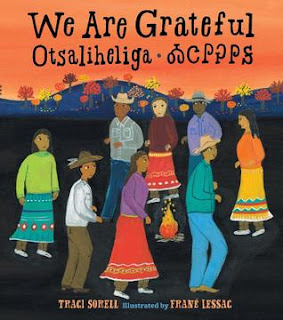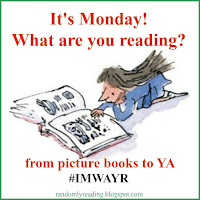When my Kiddo was growing up and I was still a classroom teacher, I always tried to stress the importance of gratitude and kindness not just at Thanksgiving, but throughout the year. I grew up in a house where my dad would always remind us of how grateful he was that he could come to this country and live a better life than what he would have had otherwise. As a young immigrant, people were not always kind to him and so he tried not to follow their example, and made it a point to help others. This year, I have found a few wonderful books that really express the idea of thankfulness and the way it was passed on to me, and the way I tried to pass it on to my Kiddo and my young students in the Bronx, many of whom were also the children of immigrants.
Thank You, Omu! written and illustrated by Oge Mora
Little, Brown BFYR, 2018, 40 pages
Omu (AH-moo, Igbo for queen, or sometimes grandma, see Author's Note for more information) has made a thick red stew for her evening meal. Omu's stew is so good that the smell wafts over the neighborhood. Just as she sits down to read a book before supper, there is a knock on her door, a little boy asking what smells so delicious. Omu gives him a bowl full of stew and he goes on his way. All through the afternoon, neighborhood people knock on Omu's door asking what smells so good, and each is given a bowl of her thick red stew. But by evening, there's nothing left for Omu to eat. There is another knock on the door, and everyone she had shared her stew with has returned, each one bringing a dish to share with Omu and each other, and so they ate, danced, and celebrated, as a way of saying Thank You, Omu. This has become one of my very favorite books and one I love to share with kids. There is so much to talk about in this simple story of kindness, generosity, and thankfulness. The neighborhood is wonderfully diverse, and shared food is the means of gathering them together. Mora's collage illustrations are done with a variety mediums, including clippings from old books, and her color palette is soft earthy tones of blues, yellows, greens, and browns resulting in images that are a warm as this charming story of Omu.

We Are Grateful: Otsaliheliga • ᏍᏟᎵᎮᎵᎦ *
written by Traci Sorell, illustrated by Frané Lessac
Charlesbridge Publishing, 2018, 32 pages
This is a lovely duel language, English and Cherokee, book about the different ways the Cherokee people express gratitude "throughout the year and across the seasons" as a reminder of both their blessings and their struggles. Following one family throughout the year, readers learn that each season is greeted by saying otsaliheliga (we are grateful), followed by descriptions of the celebrations and rituals which are observed as the seasons change. Sorell, who is a member of the Cherokee Nation, has smoothly woven into the story the different traditional and modern customs and cultural activities, including special foods, crafts, songs, and dancing that are very much a part of the Cherokee year, as well as some of the more salient events in their history. In fact, the year closes with summer, a time for the first harvest and for recalling their ancestors' sacrifices and to celebrate their history at Cherokee National Holiday. The book ends with a two page spread in a collage of illustrations from the past year, and a reminder that "Every day, every season Otsaliheliga. We are grateful." Sorell keeps the text simple throughout, and yet she manages to convey a lot of information about the Cherokee idea of gratitude, supported by equally simple, yet informative colorful gouache folk art style illustrations. Each Cherokee word used is written in both the English alphabet and Cherokee syllabary, followed by its pronunciation and definition. Back matter includes Definitions, an Author's Note, and information about the Cherokee language. This is a wonderful book for sharing with young readers, as it opens up lots of opportunity for discussion and learning.

The Thanksgiving Door
written and illustrated by Debby Atwell
Houghton Mifflin Harcourt, 2003, 32 pages
Ann and Ed are an elderly couple living alone. When Ann accidentally burns their Thanksgiving dinner, she thinks the day is ruined, but then Ed suggests that they try the new restaurant down the street, the New World Café. Luckily, the door is open and there is even a table set and decorated for the holiday. But the owners, an Eastern European immigrant family in the kitchen getting ready to celebrate their first Thanksgiving, are in a tizzy, the restaurant is closed for the day and now they have two unwanted customers. When the grandmother hears the family's complaints, she reminds them that it's Thanksgiving, a day to share. The family gracefully welcomes Ann and Ed, and, because of a simple act of kindness, new friends are made and everyone has a wonderful day eating, socializing and ever dancing. This has been one of my favorite stories and my kids in school also loved it when I read it. It really opened up some lively discussions of how different people make Thanksgiving their own, particularly when it comes to what food is served. But, no matter how different Thanksgiving table may have been, one thing always remained constant across the board- family, togetherness, sharing, and thankfulness. Interestingly, Atwell's colorful folkloric illustrations are the only indication of where the immigrant family comes from and what their religion might be.
Last but not least is a book I read earlier this year that popped into my mind when I was thinking about this post because of the impact it had on me when I first read it.
The Old Man by Sarah V. Dubois, illustrated by Claude K. Dubois
Gecko Press, 2018, 72 pages
It's morning and everyone is waking up, including a little girl who goes to school and the homeless man who has spent a cold wet night in a bus shelter. Now, though, as people arrive at the bus shelter, he has to move on. As he walks the streets, the old man feels so hungry and stops to rummage through a trash basket, looking for something to eat and sharing what he finds with a familiar stray cat he calls Dumpling. After being chased from a park where he stops to rest, and still really hungry, the old man goes to the local shelter. After waiting on a long line, he's asked his name, but he can't remember and just leaves. Outside, he gets on an empty bus and rides until it fills up and he's forced to get off. The old man goes into another park, and decides he can rest under his blanket for a while without anyone noticing him, until the little girl the reader has met at the beginning of the book asks him if he wants her sandwich and tells him he looks like a teddy bear. The old man thinks it's the best sandwich in the world. He decides to go back to the shelter, and when they ask his name, he tells them it's Teddy. At first glance, you must be wondering why I chose the story of a homeless man for a Thanksgiving post, but when I read this to my kids, the discussion centered around the little girl's act of kindness and what a difference that made for the old man. Some of my kids felt it was the sandwich that did it, but a few thought it was giving him a name was the real act of kindness because the little girl actually saw him as a person, and with the name, other would see him the same way, beginning with the shelter. It was a lively discussion and one that lead me to consider this simple, but poignant story for a Thanksgiving post. After all, is there really much of a difference between the immigrant family sharing their Thanksgiving meal with Ed and Ann and the little girl sharing her lunch with a hungry homeless man?
Three of these books are not be about Thanksgiving per se, yet all four carrying the kind of idea that I like to think of as the essence of the day. And I think all of them will be classics that we will return to during the holiday season, and throughout the year. I hope you read and enjoy them as much as my kids and I did.
"Thanksgiving is a time of togetherness and gratitude"
Nigel Hamilton


























































